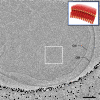Role of HAMP domains in chemotaxis signaling by bacterial chemoreceptors
- PMID: 18940922
- PMCID: PMC2570609
- DOI: 10.1073/pnas.0806401105
Role of HAMP domains in chemotaxis signaling by bacterial chemoreceptors
Abstract
Bacterial chemoreceptors undergo conformational changes in response to variations in the concentration of extracellular ligands. These changes in chemoreceptor structure initiate a series of signaling events that ultimately result in regulation of rotation of the flagellar motor. Here we have used cryo-electron tomography combined with 3D averaging to determine the in situ structure of chemoreceptor assemblies in Escherichia coli cells that have been engineered to overproduce the serine chemoreceptor Tsr. We demonstrate that chemoreceptors are organized as trimers of receptor dimers and display two distinct conformations that differ principally in arrangement of the HAMP domains within each trimer. Ligand binding and methylation alter the distribution of chemoreceptors between the two conformations, with serine binding favoring the "expanded" conformation and chemoreceptor methylation favoring the "compact" conformation. The distinct positions of chemoreceptor HAMP domains within the context of a trimeric unit are thus likely to represent important aspects of chemoreceptor structural changes relevant to chemotaxis signaling. Based on these results, we propose that the compact and expanded conformations represent the "kinase-on" and "kinase-off" states of chemoreceptor trimers, respectively.
Conflict of interest statement
The authors declare no conflict of interest.
Figures






Similar articles
-
A zipped-helix cap potentiates HAMP domain control of chemoreceptor signaling.Proc Natl Acad Sci U S A. 2018 Apr 10;115(15):E3519-E3528. doi: 10.1073/pnas.1721554115. Epub 2018 Mar 26. Proc Natl Acad Sci U S A. 2018. PMID: 29581254 Free PMC article.
-
In Situ Conformational Changes of the Escherichia coli Serine Chemoreceptor in Different Signaling States.mBio. 2019 Jul 2;10(4):e00973-19. doi: 10.1128/mBio.00973-19. mBio. 2019. PMID: 31266867 Free PMC article.
-
Conformational suppression of inter-receptor signaling defects.Proc Natl Acad Sci U S A. 2006 Jun 13;103(24):9292-7. doi: 10.1073/pnas.0602135103. Epub 2006 Jun 2. Proc Natl Acad Sci U S A. 2006. PMID: 16751275 Free PMC article.
-
Stimulus response coupling in bacterial chemotaxis: receptor dimers in signalling arrays.Mol Microbiol. 1998 Nov;30(3):459-66. doi: 10.1046/j.1365-2958.1998.01066.x. Mol Microbiol. 1998. PMID: 9822812 Review.
-
Signaling and sensory adaptation in Escherichia coli chemoreceptors: 2015 update.Trends Microbiol. 2015 May;23(5):257-66. doi: 10.1016/j.tim.2015.03.003. Epub 2015 Mar 30. Trends Microbiol. 2015. PMID: 25834953 Free PMC article. Review.
Cited by
-
Transmembrane helix dynamics of bacterial chemoreceptors supports a piston model of signalling.PLoS Comput Biol. 2011 Oct;7(10):e1002204. doi: 10.1371/journal.pcbi.1002204. Epub 2011 Oct 20. PLoS Comput Biol. 2011. PMID: 22028633 Free PMC article.
-
Mechanism of bacterial signal transduction revealed by molecular dynamics of Tsr dimers and trimers of dimers in lipid vesicles.PLoS Comput Biol. 2012;8(9):e1002685. doi: 10.1371/journal.pcbi.1002685. Epub 2012 Sep 20. PLoS Comput Biol. 2012. PMID: 23028283 Free PMC article.
-
Multistep Signaling in Nature: A Close-Up of Geobacter Chemotaxis Sensing.Int J Mol Sci. 2021 Aug 21;22(16):9034. doi: 10.3390/ijms22169034. Int J Mol Sci. 2021. PMID: 34445739 Free PMC article. Review.
-
Quantitative modeling of bacterial chemotaxis: signal amplification and accurate adaptation.Annu Rev Biophys. 2013;42:337-59. doi: 10.1146/annurev-biophys-083012-130358. Epub 2013 Feb 28. Annu Rev Biophys. 2013. PMID: 23451887 Free PMC article. Review.
-
Cryo-electron tomography of bacteria: progress, challenges and future prospects.Nat Rev Microbiol. 2009 Sep;7(9):666-75. doi: 10.1038/nrmicro2183. Epub 2009 Aug 10. Nat Rev Microbiol. 2009. PMID: 19668224 Free PMC article. Review.
References
-
- Wadhams GH, Armitage JP. Making sense of it all: Bacterial chemotaxis. Nat Rev Mol Cell Biol. 2004;5:1024–1037. - PubMed
-
- Webre DJ, Wolanin PM, Stock JB. Modulated receptor interactions in bacterial transmembrane signaling. Trends Cell Biol. 2004;14:478–482. - PubMed
-
- Studdert CA, Parkinson JS. In vivo crosslinking methods for analyzing the assembly and architecture of chemoreceptor arrays. Methods Enzymol. 2007;423:414–431. - PubMed
Publication types
MeSH terms
Substances
Grants and funding
LinkOut - more resources
Full Text Sources
Other Literature Sources
Molecular Biology Databases

